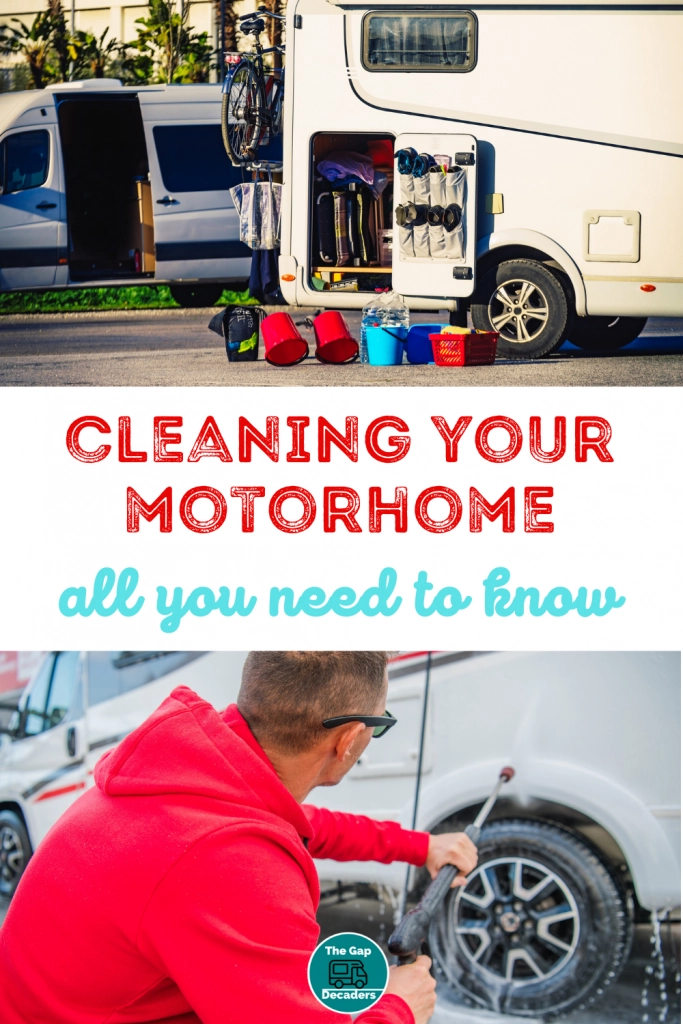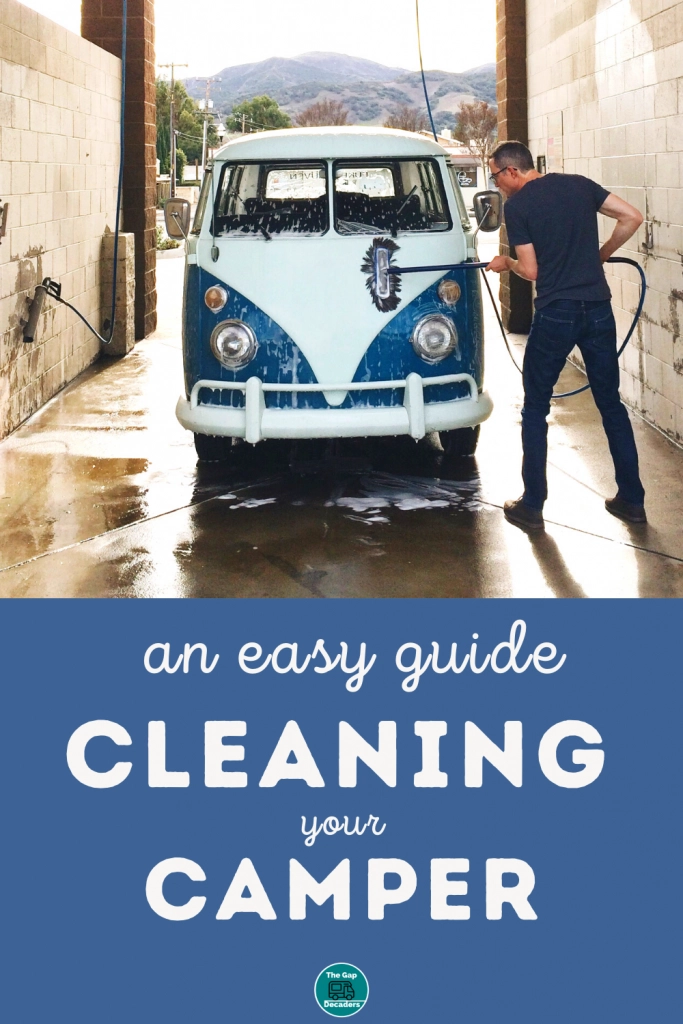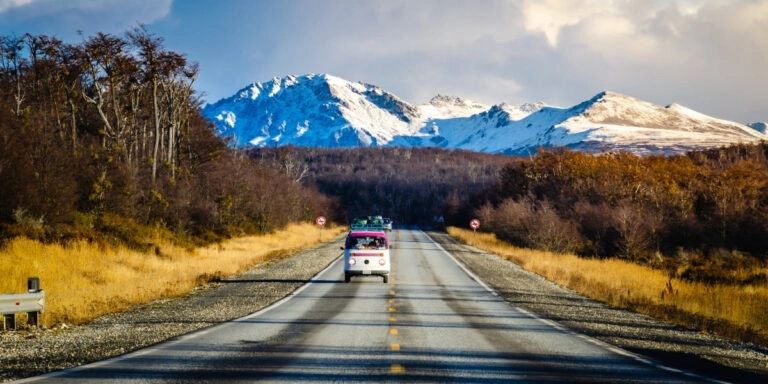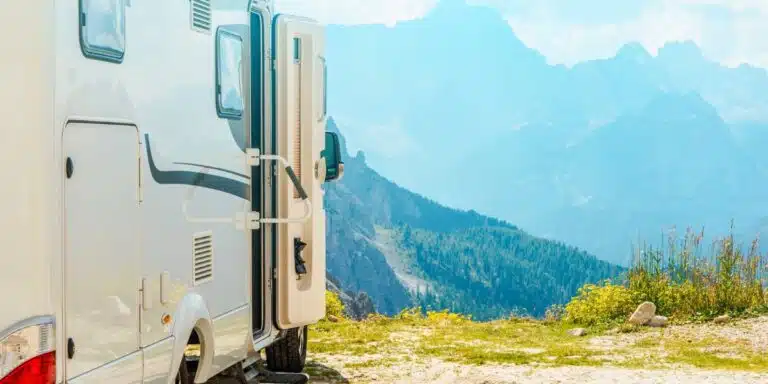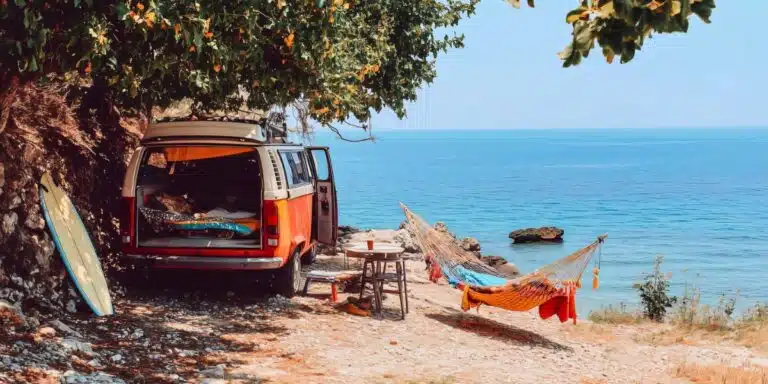This post may contain affiliate links, from which we earn an income. Click here to read our affiliate policy.
Motorhome Cleaning – Keep Your Camper Sparkling!
When you live and travel in a motorhome, it gets dirty, just like your house 🙁 With a motorhome or camper, there are areas which need special attention and care to keep them clean – from the acrylic habitation windows to the solar panels on the roof, and everything in between.
We’ll show you how to clean a motorhome using the best methods and products to keep your home on wheels spick and span, and we’ll also share a few DIY motorhome cleaning tips too.
Where Do I Clean My Motorhome?
Well, first off, don’t take it through an automatic wash, even if it’s designed for trucks. Your motorhome is not a truck and there are lots of areas, such as windows, which can get damaged by automatic wash brushes and other equipment.
If you have a ladder and sufficient space at home, your drive is probably the best option.
If you travel full-time like us, or live in your motorhome for more than a month at a time, you’ll need to find somewhere on the road.
The best option is a specialist motorhome cleaning station or truck cleaning stop, where there are gantries with stairs which help you reach the high bits of the van. You’ll also find that the washing brushes and lances are on a much higher arm than usual, allowing you to pull them over and around the van without hindrance.
You could also check into a campsite with fully serviced pitches where you have access to water. Be aware that not all campsites will be happy about you cleaning your motorhome on a pitch – some won’t mind but it’s best to check first.
We carry a box of all our cleaning stuff in the garage so we’re ready to go when we pull up. You’ll need change for the machine and all your cleaning gear ready to maximise the time the machine runs for.
When Should I Clean My Motorhome?
Motorhome exterior cleaning is best done on a cooler or overcast day. If it’s too hot, your specialist cleaning products will dry before you have a chance to rinse them off, causing streaks where you really don’t want them!
Make sure you’ve got plenty of time – it generally takes us at least 90 minutes to two hours to do a reasonable job and leave with a clean motorhome.
Most motorhomers will clean their van at the start of the season and again at the end, before the van is stored for the winter.
Longer term motorhome travellers will look to clean every couple of months, but this will depend on how many hours the motorhome is being driven, where it’s parked and the country you’re in. If you’re planning a DIY habitation check, it’s a good idea to do both at the same time.
Touring in Spain for example makes everything dusty, and the temperatures are punishing for your rubber and bodywork, so you may want to wash your van more regularly.
Basic Motorhome Cleaning Kit
This is the cleaning equipment we carry in the van, but you’ll also need the same kit if you clean your camper at home;
Cleaning a Motorhome Roof
“How do I clean a motorhome roof?” is something we get asked a lot. Most motorhome roofs have lots of kit on them – roof lights, solar panels, air conditioning outlets, vents and motorhome wifi aerials are just some of the stuff we carry around.
You’ll also notice gutters along the sides and around a/c units, which are designed to carry away rain water and the water produced by your air con.
You don’t usually see the roof (unless you like to play with a drone), but get on a ladder and take a look. If you’ve never cleaned it, it will be covered in black and green algae and mould which builds up over time.
This debris and stubborn dirt can cause havoc with your solar panels, reducing their efficiency, and block vents. You also risk long-term damage to the clear coat as the dirt, and very probably bird droppings, erode the paint and eat away at the layers underneath.
Don’t panic, this takes a long time – years and years – but it’s good practice to clean your roof at least once a year to guard against ongoing damage.
Can I stand on my motorhome roof?
That depends on the make and model of your van. Some vans are sturdier than others and the roof can comfortably support the weight of an adult, but others could suffer damage.
It’s best to check with the manufacturer or refer to the motorhome handbook before you jump up on the roof.
Can I pressure wash my campervan roof?
Yes, but with caution. Although it may seem like the quick and easy option, your motorhome roof and the fittings are not designed to be blasted with water from a jet washer at close range.
The most vulnerable areas are around window and roof light seals which can be damaged by the force of the water, creating places where water can ingress, leading to leaks and damp inside.
This is especially true if your motorhome is a bit older as the rubber will have started the natural process of deteriorating, and be less able to withstand the blast.
Also avoid fittings such as grommets around wiring going into or coming out of the roof, areas where vents extrude and the vents themselves (such as fridge vents or SOG toilet vents) or there are obvious seals between different materials.
If you’re using a gantry, you can step back a little with the lance to create a mist rather than a jet.
It goes without saying, that this follows for the whole exterior of your motorhome, not just the roof!
What about solar panels?
Solar panels need a bit more attention than the rest of the roof. Debris can gather under them and get caught, so this needs to be brushed out where possible.
Clean the panel itself with a car wash sponge or wash mitt (keep one just for this purpose as you don’t want to scratch the panels) and warm water to get rid of the worst of the dirt.
Then clean using this specialist solar panel cleaner which leaves a film on the solar panel, protecting it from further build up of dirt.
And the rest of the roof?
Option 1
Hot soapy water and elbow grease do an amazing job, if you’ve got the time and energy. Use the gantry or a ladder to get up to the level of the roof and cover it with a mix of warm water and this specialist motorhome body cleaner. Use your extending brush to get good coverage before rinsing off with a bucket of clean water, or use the lance at the wash down point.
Option 2
Use a cleaner like Wet & Forget. This is a solution that you spray onto your motorhome roof and leave. That’s it! No scrubbing or messing about, just spray it on and the next time it rains, the solution will lift all the algae, moss and mould from your roof like magic.
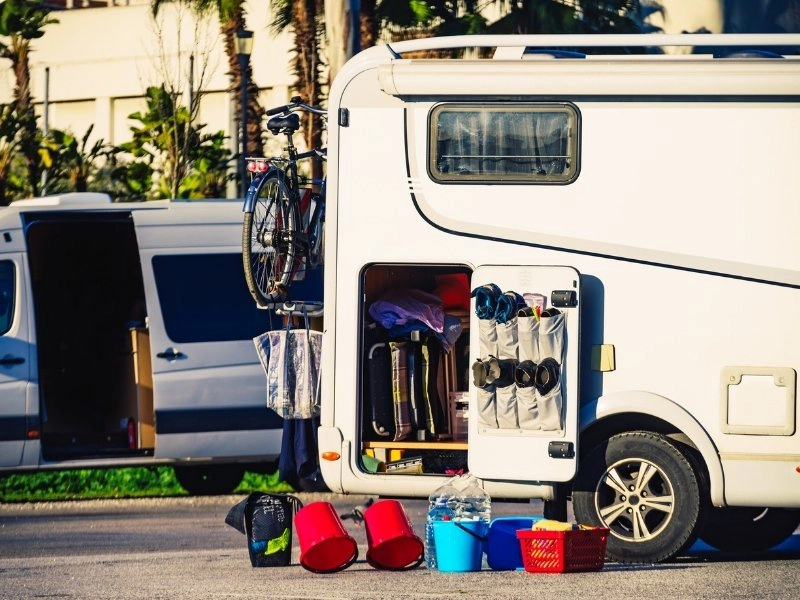
Cleaning the Body of a Motorhome
In comparison to cleaning the roof, this is a bit easier, although you’ll still need a ladder, gantry or step up to get to the highest points.
We always use Fenwicks Motorhome Cleaner Concentrate, which is perfect for cleaning all parts of your motorhome exterior. It creates a really good soapy mixture which rinses off well and doesn’t leave streaks. This all-rounder can be used for windows, wheels and tyres.
Most wash points will have a soap cycle where a cleaner is dispensed in the water that comes out of the brush – we tend to skip this cycle and use our own liquid and water.
Always wash from top to bottom to ensure that debris is never washed over a clean area.
Can’t I just use washing up liquid?
Well, you can but it will leave streaks and a bit of a slimy residue which can be hard to rinse off. Washing up liquid also contains ammonia (motorhome wash is PH neutral) and other chemicals which could damage your bodywork over time.
If you’re desperate, a good alternative to traditional motorhome and car wash cleaners is shampoo. Shampoo is PH balanced and so won’t cause any damage to your paintwork.
How do I remove black streaks?
Black streaks are caused by the rubber seals around your doors, windows, gutters and roof-lights deteriorating through weathering, UV damage and heat. Over time small particles come away and mix with dust in the environment, the grime on your roof and air pollution, all of which colours any run-off water.
The run-off water generally follows the same path to the ground, and over time black streaks start to appear where the mixture is left behind, along with the calcium and lime deposits in the water. This is a potent mix and the resulting marks can be extremely stubborn!
We have tried every black streak cleaner going, and now use Caravan King Black Streak Remover. This tried and tested product works really well for us – remember that if you use it over wax, you’ll need to re-apply the wax again.
The best way to use this product is to spray it directly onto the black streak and rub vigorously with a barely damp cloth. Do not use this product on glass or acrylic windows.
The one area where we have been defeated by black steaks in on our decals – if the run-off happens to go over your decals, you’ll also find a black streak appearing there. We must have tried five or six different products with no luck – we asked the manufacturer of our motorhome what they recommended and they told us to get new decals!
Can I prevent black streaks?
To a degree, yes.
Clean your motorhome regularly to keep on top of black streaks. If you leave them to settle in, they can be really hard to remove.
Waxing provides a preventive layer which which helps to repel the contaminants that cause black streaks. We’ll talk more about waxing later in the post.
It also helps to keep seals in good order, to prevent them from the effects of extreme temperatures and weather. Do this by using a rubber seal protectant which will keep your seals lubricated and conditioned.
If your motorhome is going into storage out in the open, consider a cover to prevent the inevitable black streaks.
What about bug removal?
All the areas at the front of your motorhome, like the bonnet, mirrors, grill and headlights spend their whole time on the road slamming into thousands of bugs and flies.
The result at the end of a day on the road is a mess! Leave this for even a few days and the bugs get baked hard onto your van, making them really difficult to remove.
Regular washing won’t shift them. Try a specialist product like Autoglym Active Insect Remover. Spray on after your regular wash, leave for a minute or so, agitate with a soft brush if necessary, then wipe off. This is a really excellent product which we wouldn’t be without.
How do I shift tar?
Tar is a hazard for all vehicles, motorhomes included. When the weather is warm or you drive on a recently laid surface, the tar is soft and gets thrown up by your tyres.
This can adhere to the bodywork on the sides of your motorhome, and sticks like glue.
If you have any tar remaining on your bodywork after your normal wash, use Autoglym Intensive Tar Remover, which you apply with a microfibre cloth. The liquid dissolves the components of the tar almost immediately leaving your van mark free.
More Motorhome Guides
Cleaning Motorhome Windows
Motorhome habitation windows are generally acrylic, and the cab windows and windscreen are glass.
This means you may need two different types of products to clean effectively. This is particularly important for acrylic windows which can be damaged by the harsh solvents found in some cleaners.
There is one dual-purpose product which can clean both glass and acrylic – Autoglym Fast Glass. If space is at a premium and you only want to carry one glass cleaning product, then this is the one for you.
How do I get the windscreen streak free?
The windscreen takes a real battering, and gets covered with dead bugs, grit and other road debris.
How should I clean my habitation windows?
Habitation windows are almost always made from acrylic (unless you’re in an overland vehicle where they might be glass).
If they are particularly dirty outside, wash with plain warm water before using a specialist motorhome acrylic window cleaner, which is also suitable for the inside of the window.
You can use a lint free microfibre cloth to polish off, or kitchen roll, which works just as well.
Once you’ve done cleaning, it’s an ideal time to check the seals and protect them if necessary.
How can I remove scratches from acrylic windows?
Clean the plastic surface with a damp cloth and then try lightly applying a mild abrasive, such as toothpaste or baking soda to the scratch. This will work well with light scratches but you may not be able to remove deeper scratches with this DIY method.
Vuplex Plastic Cleaner and Polish is specially designed for cleaning plastics like acrylic and won’t cause any damage to your windows – try it if using regular household abrasives doesn’t work.
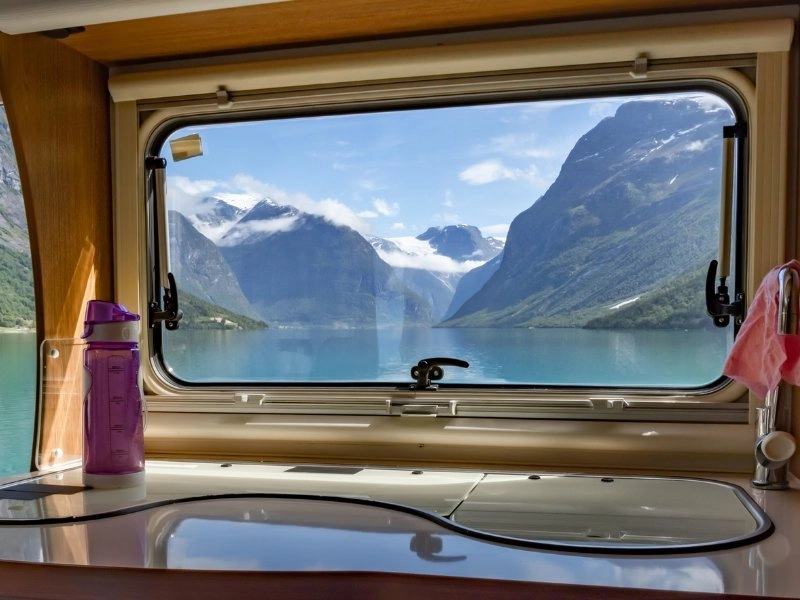
Cleaning Motorhome Wheels & Tyres
Motorhome wheels get REALLY grubby, with all the grease, salt, road grime and brake dust they have to deal with.
Give your wheels and tyres a good once over with your regular soapy water mixture, remembering to get under the arches. This will take off the worst of the grime – you can use a jet washer on your wheels to rinse off the soap suds.
The next step is to apply a product like AutoGlym Clean Wheels and leave for a few minutes. Use a wheel brush like this one to agitate the solution and then rinse off.
If you want to finish your tyres, use a pigmented tyre serum which conditions and protects the rubber.
Cleaning a Motorhome Awning
Roll out awnings are prone to getting dirty underneath – if your awning is put away with even the smallest hint of damp present, then mould will form as the awning rolled tightly away with no chance to breath.
The best prevention for your awning getting dirty is not to roll it away damp, but in reality this is almost impossible.
We use Care-avan Awning Cleaner which kills mold and mildew. Before our current motorhome I would have said to just use any old soapy water, but we bought this when our current (new to us) van awning had quite a few mould stains which I just couldn’t shift.
It’s quite hard work as you have to open the awning out and stand on something to reach – you can’t scrub too hard as there’s nothing but air on the other side of the awning fabric. A soft scrubbing brush is ideal for this job.
I have to confess to not cleaning the top of the awning though, that’s just too difficult!
Waxing a Motorhome
As we already mentioned, waxing is a great way to help prevent black streaks, and also makes them easier to clean off when they do appear.
Waxing also helps your motorhome to retain the new shiny appearance we all love.
It’s time consuming and after your hour of cleaning, probably the last thing you want to do, but it will make all your cleaning efforts in the future a little bit easier.
You could use a dual-purpose product like this Dirtbusters Motorhome Wash and Wax, which adds the wax element to the cleaning product, or try this King of Sheen Professional Caravan & Motorhome Waterless Wash and Wax, which claims to clean and wax without water.
If you want to wax your van the old-fashioned way, then we would recommend Seal-er Camper Motorhomes & Caravans Waterless Pure Carnauba Wax which you spray on and polish off.
If you want a product that requires no polishing, then try Fenwicks Bobby Dazzler, which provides a non-wax protective coating that is repellent against water, dirt and algae.
Are you looking for more motorhome tips & tricks? Check out these top posts…
Must-Have Storage Ideas for Your Home on Wheels
Must-Have Mobility Aids for a Comfortable Motorhome Journey
MOT for Long-Term Travel Outside the UK: All You Need to Know
Reinvent Your Life: The Ultimate Gap Year Guide for Over 50s
Motorhome Life: Should You Sell Up to Travel Like We Did?
Why a Motorhome Adventure in Europe Should Be Your Next Trip
Love it? Pin it!
